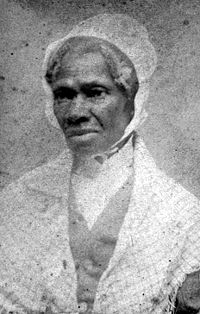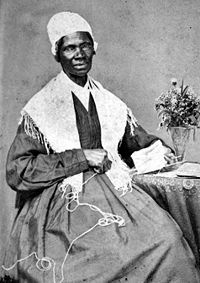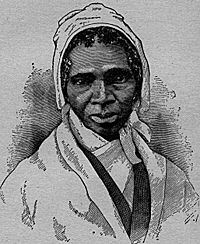Sojourner Truth
Sojourner Truth (circa. 1797–1883) was a slave who became famous for being an American abolitionist. She was a self-proclaimed Evangelist, who changed her name based on a revelation she received in 1843.
She was born Isabella Bomefree(later changed to Baumfree) in the Dutch settlement of Hurley in upstate New York. Born into a large slave family she was sold four different times before finding freedom.
The painful experiences of being a child, wife, and mother who had to endure slavery and her personal religious experiences formed a personality that made her a courageous advocate for slaves and an avid supporter of women's rights as well.
Despite the fact that she could not read or write she won three different court cases against whites in her lifetime and became a respected and influential public speaker.
Early Life
Born to James and Betsy Baumfree, Isabella's family was owned by the Dutch-speaking Johannes Hardenbergh, who operated a gristmill and owned a substantial amount of property. He had been a member of the New York colonial assembly and a colonel in the Revolutionary War. Because the Hardenbergh's were a Dutch-speaking family, Isabella spoke only Dutch as a small child. She is believed to have had anywhere from 10 to 13 brothers and sisters. The records are unclear because many were sold away.
In 1799, Johannes Hardenbergh died and Isabella became the slave of his son, Charles Hardenbergh. When Isabella was around nine years old her new master died and her mother and father were both freed due to their old age. However, Isabella and her younger brother were put up for auction. She was sold for $100 to John Neely, a man who owned a store near the village of Kingston. She rarely saw her parents after this time.
During her time with the Neely's she received many severe whippings for not responding to orders. Her only crime was that she did not speak English and therefore did not understand their commands. After two years with the Neely's, she was sold to Martinus Schryver, a fisherman who lived in Kingston. In 1810, at the age of 13, she became the property of John Dumont. She worked for him for 17 years. Dumont had a small farm and only a few slaves. While working on Dumont's farm, Isabella was praised for being hard working. According to Isabella, Dumont was a humane master who only whipped her once when she tormented a cat.
Around 1816, Isabella married Tom, another slave owned by Dumont. He was older than Isabella and had already been married two times before. They had five children together.
In 1799, New York adopted a law that gradually abolished slavery. According to the law, on July 4, 1827, all slaves within the state would be freed. When Dumont reneged on a promise to free Tom and Isabella on July 4, 1826, she left the Dumont farm with only her infant daughter a few months later. Leaving Tom and three other children behind, she walked several miles to the house of Levi Roe, a Quaker. Roe told her to go to the home of Isaac and Maria Van Wagenen who lived in Wahkendall. The Van Wageners bought her from Dumont when he showed up wanting her back and then freed her.
Fighting for her rights
Unlike those who fled from southern slavery, Isabella was able to remain in her home state as a free woman. While denied full citizenship rights in that state, one of the first things she did after obtaining her freedom was to sue for the freedom of her son Peter. Her 6-year-old son Peter had been given away as a present to Sally Dumont's sister. The sister's husband decided to sell Peter to a man that then illegally sold him to Alabama. (New York, as part of the law that was gradually eradicating slavery, refused to allow slaves in New York be sold to any other state, in order that these residents of the state would indeed gain their freedom as the designated date.) When Isabella learned that her son had been sold the Van Wagenen's suggested that she hire a lawyer and sue, and helped her raise the funds to pay the lawyer. She won the case and her son was returned to her.This would be the first of three court cases she would eventually win.
After winning the case she and Peter traveled to New York City to find work as servants to wealthy families. Mr. and Mrs. Latourette were her first employers. During this time she was able to experience a reunion with some of her sisters and a brother who was sold before she was born. It was also her first experience of a black community —something completely non-existent in the rural areas where she had lived.
Religious Life
During the time she spent with the Van Wagenens, she underwent a religious experience that began her transformation to becoming Sojourner Truth. According to her dictated autobiography, one day "God revealed himself to her, with all the suddenness of a flash of lightning, showing her, 'in the twinkling of an eye, that he was all over,' that he pervaded the universe, 'and that there was no place where God was not.'"
When she first moved to New York in 1829 she attended a class for Negroes at the John Street Methodist Church, but later she joined the A.M.E. Zion Church on Church and Leonard Street. She began preaching occasionally at this time, telling the story of her conversion, and singing her story to listeners.
In the early 1830s Isabella began to work for a Mr. Pierson. Her employer thought he was a re-incarnation of Elijah from the Bible and he developed a relationship with Robert Matthews, who imagined himself, the Second Coming of Christ, and called himself the Prophet Matthias. [1] This was a time of self-styled religious prophets and these men developed a following that included Isabella. She ended up moving with them to an estate in Western New York, where they tried an experiment in communal living. When Mr. Pierson died suspiciously, the entire group found themselves splashed all over the newspapers—Matthews was accused of murder and Isabella was accused of poisoning two of the members. Matthews was acquitted of the murder (although he did spend some months in prison for beating his daughter severely.) Isabella was also acquitted, and successfully sued the couple that accused her for slander.
After this experience she returned briefly to New York and again worked as a servant. But it wasn't long before she decided to leave New York City. On June 1, 1843, she gathered together a few belongings that she could easily carry and before long she set out on her own singing her story to revival groups, and becoming a popular preacher. It was about this time also that she received a revelation from God to call herself Sojourner Truth.
She once visited the house of Harriet Beecher Stowe while several well-known ministers were there. When asked if she preached from the Bible, Truth said no, because she couldn't read. "When I preaches," she said, "I has just one text to preach from, an' I always preaches from this one. My text is, 'When I found Jesus.' "
In 1850 she decided to tell her story to Olive Gilbert and it was published as Narrative of Sojourner Truth: A Northern Slave. The popularity of Frederick Douglass' book about his journey to freedom gave her hope that her book might earn enough money to permit her to purchase a home of her own. More importantly, she wanted to tell the story of a northern slave.
She went around the northern states, selling her book, and telling her life story. In 1851, she spoke at the Women's Rights convention in Akron, Ohio, and gave a stirring speech on behalf of women—this became known as the "Ain't I a Woman?"[2] speech, denouncing the idea of feminine fragility.
Later Life
Sojourner Truth owned property in Northampton, Massachusetts before the Quaker Henry Willis brought her to Battle Creek, Michigan to speak on October 4, 1856. As a result of this trip Truth then bought a home at Harmonia in 1861, which is now part of the Fort Custer Industrial Park. This property was sold by her heirs in 1896.
During the American Civil War, she organized collection of supplies for the Union, and moved to Washington, D.C. after the Emancipation Proclamation was issued, to work with former slaves. Working for the Freedman's Bureau, she taught newly freed slaves the skills they would need to be successful. Almost 100 years before Rosa Parks, Sojourner Truth also fought for the right to ride the streetcars in Washington, DC and won.
By the end of the Civil War, Truth had met with Abraham Lincoln, had her arm dislocated by a racist streetcar conductor and won a lawsuit against him, spoke before Congress petitioning the government to make western lands available to freed blacks, and made countless speeches on behalf of African Americans and women.
She returned to Michigan in 1867 and died at her home in Battle Creek, Michigan, on November 26, 1883. She is purported to have said towards the end, "I'm goin' home like a shootin' star." She is buried in Oak Hill Cemetery in Battle Creek. In 1983, she was inducted into the Michigan Women's Hall of Fame.
Quotes
"Keeping the Thing Going While Things are Stirring" May 9, 1867
My friends, I am rejoiced that you are glad, but I don't know how you will feel when I get through. I come from another field- the country of the slave. They have got their liberty; so much good luck to have slavery partly destroyed; not entirely. I want it root & branch, destroyed. Then we will all be free. indeed. I feel that if I have to answer for the deeds done in my body just as much as a man, I have a right to have just as much as a man. There is a great stir about colored men getting their rights, but not a word about colored women; & if colored men get their rights, & not colored women theirs, you see the colored men will be masters over the women, & it will be just as bad as it was before. I am keeping the thing going while things are stirring, because if we wait till it is still, it will be a great while to get it going again.
"I want you to consider on this clil'n. I call you chil'n; you are somebody's chil'n, and I am old enough to be mother of all that is here. I want women to
have their rights. In the courts women have no right, no voice; nobody speaks for them. I wish woman to have her voice there among the pettifoggers. If it is not a fit place for women, it is unfit for men to be there.
I am above eighty years old; it is about time for me to be going. I have been forty years a slave & forty years free, & would be here forty years more to have equal rights for all. I suppose I am kept here because something remains for me to do; I suppose I am yet to help break the chain.'
ReferencesISBN links support NWE through referral fees
"Truth, Sojourner." Encyclopædia Britannica. 2006. Encyclopædia Britannica Online Library Edition. 22 Aug. 2006
http://www.library.eb.com/eb/article-9073571?query=Sojourner%20Truth&ct=eb#cite
Women in History. Sojourner Truth biography. Lakewood Public Library. <http://www.lkwdpl.org/wihohio/trut-soj.htm>.
1867 speech delivered May 1867 http://www.pacifict.com/ron/Sojourner.html
In 1997 the NASA Mars Pathfinder mission's robotic rover was named "Sojourner" after Sojourner Truth. [3]
In 2004, renowned author Bennett Golder wrote "The Truth About Sojourner Truth" a biographical account about the lies surrounding the life of Sojourner Truth.
External links
- Works by Sojourner Truth. Project Gutenberg
- On the trail of Sojourner Truth
- African American History
- Sojourner Truth
- Sojourner Truth Institute
- Christianity Today
- Sunshine for Women
- Africana Studies Department
- The Avalon Project
Credits
New World Encyclopedia writers and editors rewrote and completed the Wikipedia article in accordance with New World Encyclopedia standards. This article abides by terms of the Creative Commons CC-by-sa 3.0 License (CC-by-sa), which may be used and disseminated with proper attribution. Credit is due under the terms of this license that can reference both the New World Encyclopedia contributors and the selfless volunteer contributors of the Wikimedia Foundation. To cite this article click here for a list of acceptable citing formats.The history of earlier contributions by wikipedians is accessible to researchers here:
The history of this article since it was imported to New World Encyclopedia:
Note: Some restrictions may apply to use of individual images which are separately licensed.



